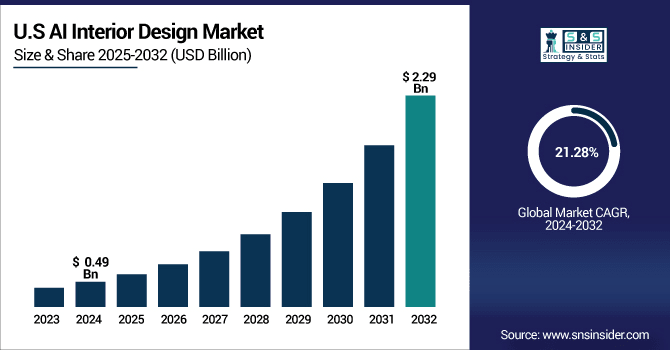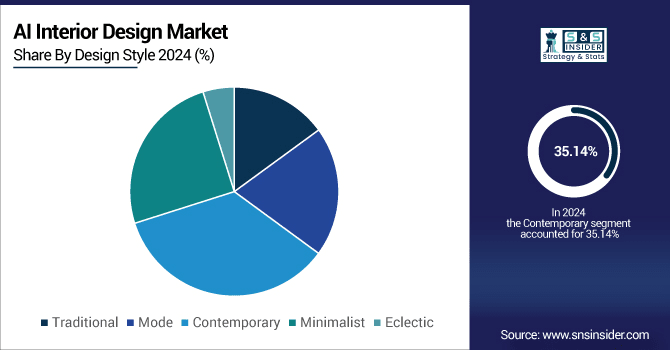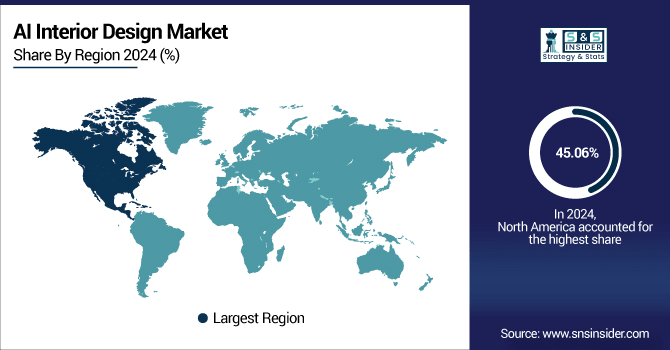AI Interior Design Market Report Scope & Overview:
The AI Interior Design Market Size was valued at USD 1.47 billion in 2024 and is expected to reach USD 6.96 billion by 2032 and grow at a CAGR of 21.51% over the forecast period 2025-2032.
The AI Interior Design market is witnessing rapid growth due to the increasing adoption of artificial intelligence technologies across residential, commercial, and hospitality sectors. Advanced AI-powered tools, such as 3D visualization, virtual reality (VR), and augmented reality (AR) applications, are enabling designers and homeowners to create highly personalized and efficient interior layouts. These technologies streamline the design process by automating space planning, color matching, and furniture placement, reducing time and costs while enhancing overall design accuracy. According to study, AI algorithms can generate up to 1,000 design variations in under an hour.

To Get More Information On AI Interior Design Market - Request Free Sample Report
AI Interior Design Market Trends
-
Rising awareness of water safety among parents, schools, resorts, and pool operators is driving adoption of drowning detection systems.
-
Increasing incidents of accidental drowning, especially among children, are prompting real-time alert solutions.
-
Regulatory support and public safety campaigns are encouraging widespread deployment of detection systems.
-
Advanced AI, machine learning, and IoT integration improve detection accuracy and reduce false alarms.
-
Wearable devices and smart bracelets are increasingly used in recreational and open-water environments.
-
Remote monitoring, centralized dashboards, and mobile alerts enhance operational efficiency across multiple facilities.
-
Affordable and accessible technology enables expansion across schools, resorts, water parks, and residential pools.
The U.S. AI Interior Design Market size was USD 0.49 billion in 2024 and is expected to reach USD 2.29 billion by 2032, growing at a CAGR of 21.28% over the forecast period of 2025-2032. Due to including rising drowning incidents, particularly among children, and the adoption of advanced technologies such as AI-powered surveillance systems and wearable devices.

AI Interior Design Market Growth Drivers:
-
Increasing Adoption of AI-Powered Design Tools
Growing adoption of AI-powered tools, such as 3D visualization, augmented reality (AR), virtual reality (VR), and machine learning algorithms, is likely to significantly drive the AI Interior Design market. This gives interior designers, architects, and homeowners the power to build real-life designs that are exceptionally precise and affordable. By automating tasks such as space planning, furniture placement, and color coordination, AI tools minimize design errors and also cut short the project completion time. Furthermore, AI platforms provide interactive virtual experiences that enable clients to visualize the final look of the interior thereby promoting more engagement and satisfaction from clients. The simplicity and effectiveness of AI is increasing the adoption of these solutions, driving the growth of the market around the world.
AI-assisted design reduces project turnaround time by 20–30% compared to traditional manual planning.
AI Interior Design Market Restraints:
-
High Implementation Costs and Technical Complexity
The high cost of implementation and technical complexity of AI tools is one of the significant factors restraining the growth of overall AI Interior Design market. High investment in hardware and software is required for the use of advanced software and VR/AR applications, which are likely to hinder the small design firms and individual homeowners. In addition, the need for specialized skills or training to use AI design platforms effectively increases operational costs and slows adoption of AI by less tech-savvy users. This problem can restrict the mass deployment of AI solutions, especially in emerging markets where the budgets and technical talent can be low.
AI Interior Design Market Opportunities:
-
Integration with Smart Home and IoT Technologies
Integrating AI with Smart home systems and IoT devices may give a significant opportunity for AI Interior Design market. With more consumers scaling into smart appliances and lighting systems, as well as smart home devices, the designs crafted by traditional methods can be automated, personalized, and energy-correct at the time of installation using a home design app powered by artificial intelligence. For instance, it could suggest the positioning of the furniture according to natural light, smart appliance space maximization, or energy efficiency. The blending of AI and IoT technology with interior design, backgrounds and guidelines is expected to enrich user experience and induce new product offerings, subscription capabilities and value-added services creating remarkable potential profitability for the market players.
AI-powered interior design tools that optimize layouts for natural light and smart appliance placement can improve energy efficiency by up to 20% in residential spaces.
AI Interior Design Market Segment Analysis
-
By User Type: In 2024, Interior Designers led the market with approximately 40.10% share, while Real Estate Developers are the fastest-growing segment with a CAGR of 22.32%.
-
By Design Style: Contemporary design dominated the market in 2024 with around 35.14% share, whereas Minimalist design is growing the fastest at a CAGR of 22.52%.
-
By Technology Integration: 3D Visualization Tools held the leading position in 2024 with roughly 35.04% share, and Augmented Reality (AR) Applications are the fastest-growing technology segment at a CAGR of 22.72%.
-
By Application: Residential Interior Design led the market in 2024 with approximately 40.12% share, while Commercial Interior Design is the fastest-growing application at a CAGR of 22.56%.
-
By Pricing Strategy: Subscription-Based Pricing dominated in 2024 with around 40.14% share, and Project-Based Pricing is the fastest-growing strategy with a CAGR of 10.10%.
By Design Style, Contemporary Leads Market While Minimalist Fastest Growth
On the basis of Design Style, the AI Interior Design market is segmented into Contemporary design dominates as the strong appropriate style of home design among styles, followed closely by Modern, with its clean lines and simplicity that makes it broadly appealing and versatile for both residential and commercial projects. American homes tend to take on contemporary layouts, as designers and homeowners prefer a more aesthetic and functional setting with the creation of AI-tools, you can quickly create your designs, getting them professionally positioned at the property with utmost accuracy and conviction. However, the fastest-growing segment is Minimalist design, which is driven by rising consumer preference for functional, space-efficient, and clutter-free interiors. Since AI technologies enable designers to optimize layouts, lighting, and furniture placement seamlessly, the minimalist trend goes perfectly with AI.

By User Type, Interior Designers Leads Market While Real Estate Developers Fastest Growth
In 2024, Interior Designers currently lead the market due to wide range of applications of AI-powered tools used by designers for client presentation, space planning, and design improvement. Interior designers use 3D visualisation, VR, and AR technology for creating space that is both highly targeted and adaptive for an individual. This segment is dominant in terms of demand due to the need to decrease project turnaround time, decrease errors, and improve client engagement, which in turn makes them the ideal candidate for AI solutions. On the other hand, Real Estate Developers are the quickest-growing user category, taking advantage of AI technologies to expedite big residential and industrial projects. It will continue because of growing investments into urbanization and smart infrastructure because developers want to provide beautiful, economically feasible, and technology-infused buildings to lure buyers.
By Technology Integration, 3D Visualization Tools Leads Market While Augmented Reality (AR) Applications Fastest Growth
3D Visualization Tools are currently dominating the market in 2024, as they are the most common tools that are used by interior designers, architects and home owners. These instruments help users in establishing realistic and interactive visualizations of interior spaces, enabling precise space planning, furniture positioning, and colour coordination. Unlike Augmented Reality (AR) Applications which is the quickest growing section. The realm of AR technology is based on the use of smartphones or AR-enabled devices, where real-world spaces get embedded with virtual furniture, decor, and design elements. Such an engaging experience allows for more client interaction and real-time decisions.
By Application, Residential Interior Design Leads Market While Commercial Interior Design Fastest Growth
Based on application, Residential Interior Design leads the segment. This is because both homeowners and interior designers have increasingly demanded personalized, efficient, and visually appealing design. They are also able to experiment with layouts, furniture, and color schemes to determine the best interior design solutions for their houses. AI tools such as 3D visualization, VR, and AR can be used for simulation and experimentation of alternative before implementation. On the other hand, Commercial Interior Design application is the fasting growing segment. Businesses, offices, co-working facilities, or cooperate spaces demand customization, space efficiency, beauty, and functionality. As the time and cost constraints in these areas have limited the use of traditional interior designs, the segment is growing rapidly in its adoption of AI interior design tools.
By Pricing Strategy, Subscription-Based Pricing Leads Market While Project-Based Pricing Fastest Growth
A Pricing Strategy segment that dives deep into the trends in adoption and growth of the AI Interior Design Market. But now Subscription-Based Pricing dominates the market as it allows users to continuously access AI-powered design tools, updates and support. The model is beloved by interior designers, architects, and businesses alike as it guarantees affordability, predictable costs, and a good stream of the coolest features as they come out making it the most popular pricing strategy out there. On the other hand, Project-Based Pricing is the fastest growing category. The subscription model caters to clients and designers undertaking bespoke or high-value projects that would prefer a payment-per-project and do not wish to subscribe to long-planned subscription periods. Project-based pricing is allowing for high adoption of AI tools as and when needed, especially for large-scale or specialized design tasks making this part segment a highly growing part.
North America AI Interior Design Market Insights:
The AI interior design tools market has a share of 45.06% and is currently dominated by north America, owing to the presence of key players, advanced technological infrastructure, and higher adoption of AI interior design tools. 3D Visualization, VR & AR applications are widely adopted among designers, architects, and homeowners in region to create custom and optimized interiors layouts. The prevalent digital ecosystem along with high awareness level regarding smart home technologies and connected devices continues to reinforce North America as the largest market for AI Interior Design during the forecast period.

Get Customized Report as Per Your Business Requirement - Enquiry Now
U.S. Leads AI Interior Design Market with Technological Adoption
The U.S. dominates the North American market owing to the high technological adoption to leverage the regional market growth along with high integration of AI powered interior design tools. The visualizations have been made very advanced due to common use of 3D visualization, AR/VR applications, and machine learning algorithms. It allows designers and homeowners to get an extremely customized and optimized design for the interior layouts. Rising investments in smart homes, connected devices, and digital design platforms are also bolstering the market as these implementations allow faster execution of AI solutions in residential properties and commercial projects. Market drivers include Government initiatives requesting for digital infrastructure and smart city development.
Asia-Pacific AI Interior Design Market Insights
Asia Pacific is poised to become the fastest growing regional market for AI Interior Design, driven by high rates of urbanization, increasing disposable incomes, and strength in the real estate sector. There is a surge of adoption of AI-driven solutions by Homeowners, Designers, and Developers to have intelligent, personalized interiors for residential and commercial projects. Modern, minimalistic design styles achieve increasing traction, and the employment of AI-based tools implements an effective way to plan spaces, visualize layouts, and do every slight adjustment to get an ideal suite result. This tremendous growth in origin is being driven by a young population adept with technology, and an increase in investment in smart infrastructure with Asia Pacific becoming one of the most appealing and lively regions in the AI Interior Design market.
China and India Drive Rapid Growth in AI Interior Design Market
The Asia Pacific market is growing strong in China and India with the increase in disposable incomes, rapid urbanization and growing real estate sector. There is rising use of AI-based design tools in housing and other projects for urban habitats, office buildings, and premium constructions. Market growth is further propelled by modern and minimalist design trends, availability of tech-savvy consumers, and investments in smart infrastructure through verticals. Moreover, rising cognizance concerning effective space utilization, eco-friendly designs, and interactive digital design platforms are also fuelling the demand for AI interior design solutions across the countries.
Europe AI Interior Design Market Insights
The Europe AI Interior Design market is growing at steady growth rate initiated by increasing adoption of AI-powered tools adoption among interior designers, architects, and homeowners. Smart homes and sustainability are the key perspectives piecing together a realization of energy-efficient interiors across the region, driving the demand for AI solutions that optimize space planning, material selection, as well as design visualization. A growing technological backbone; rising investments in housing and commercial space; and increasing exposure to digital design platforms all bolster market expansion.
Germany Leads Europe in AI Interior Design Market Growth
The high adoption of AI-powered design tools and smart home technologies in countries such as Germany and the U.K. puts them at the forefront of the Europe AI Interior Design Market. Today use of 3D visualization, VR/AR applications & machine learning outlined algorithm enables various designers, architects & home owners to design its interiors in a most unique manner. They assist in efficient space planning, layout optimization, and real-time design visualization, leading to improved decision-making and client interaction.
Latin America (LATAM) and Middle East & Africa (MEA) AI Interior Design Market Insights
The Latin America and Middle East AI Interior Design market is experiencing steady growth, driven by urbanization, rising disposable incomes, and increasing investments in residential, commercial, and luxury projects. Adoption of AI-powered tools, such as 3D visualization, VR/AR applications, and machine learning algorithms, is helping designers and homeowners optimize space planning, furniture placement, and design visualization. The market is further supported by growing interest in smart homes, digital infrastructure, and contemporary design trends, which is accelerating the uptake of AI solutions across residential, hospitality, and commercial sectors.
AI Interior Design Market Competitive Landscape
RoomGPT is a platform that provides AI-powered room redesign solutions, enabling users to transform their spaces in various styles quickly and easily. The company focuses on making interior design accessible and interactive for homeowners and DIY enthusiasts.
-
In June 2025, RoomGPT introduced an enhanced AI-powered room redesign tool that allows users to upload a photo of their space and receive instant design transformations in various styles, making interior design more accessible to homeowners.
Coohom is a provider of AI-driven interior design solutions, offering tools for 3D visualization, furniture placement, and virtual room planning. The company aims to streamline the design process for professionals and DIY users alike.
-
In June 2025, Coohom released a new AI Image Generator feature that enables users to create photorealistic 3D renderings of their interior designs, streamlining the design process for professionals and DIY enthusiasts alike.
Planner 5D is a global interior design platform that integrates AI tools to assist designers and homeowners in creating customized 2D and 3D layouts. The company focuses on providing accessible, user-friendly solutions for home and commercial projects.
-
In August 2025, Planner 5D released insights from a global user survey, revealing that kitchens, living rooms, bathrooms, and bedrooms remain the most frequently designed spaces worldwide, highlighting the platform's widespread usage among interior designers.
AI Interior Design Market Key Players:
Some of the AI Interior Design Market Companies are:
-
RoomGPT
-
InteriorAI
-
Coohom
-
Spacejoy
-
Morpholio
-
Planner 5D
-
RoomSketcher
-
Foyr
-
ZMO.AI
-
Spayci
-
Superside
-
Spacely AI
-
Box Clever Interiors
-
REImagine Home
-
Autodesk
-
IBM Corporation
-
Microsoft
-
IKEA
-
Houzz Inc.
-
Cylindo
| Report Attributes | Details |
|---|---|
| Market Size in 2024 | USD 1.47 Billion |
| Market Size by 2032 | USD 6.96 Billion |
| CAGR | CAGR of 21.51% From 2025 to 2032 |
| Base Year | 2024 |
| Forecast Period | 2025-2032 |
| Historical Data | 2021-2023 |
| Report Scope & Coverage | Market Size, Segments Analysis, Competitive Landscape, Regional Analysis, DROC & SWOT Analysis, Forecast Outlook |
| Key Segments | • By User Type (Homeowners, Real Estate Developers, Interior Designers, Architects, and Corporate Clients) • By Design Style (Traditional, Modern, Contemporary, Minimalist, and Eclectic) • By Technology Integration (3D Visualization Tools, Virtual Reality (VR) Solutions, Augmented Reality (AR) Applications, Computer-Aided Design (CAD) Software, and Machine Learning Algorithms) • By Application (Residential Interior Design, Commercial Interior Design, Hospitality Interior Design, Event and Exhibition Design, and Retail Interior Design) • By Pricing Strategy (Freemium Models, Subscription-Based Pricing, One-Time Purchase Options, Tiered Pricing Models, and Project-Based Pricing) |
| Regional Analysis/Coverage | North America (US, Canada), Europe (Germany, UK, France, Italy, Spain, Russia, Poland, Rest of Europe), Asia Pacific (China, India, Japan, South Korea, Australia, ASEAN Countries, Rest of Asia Pacific), Middle East & Africa (UAE, Saudi Arabia, Qatar, South Africa, Rest of Middle East & Africa), Latin America (Brazil, Argentina, Mexico, Colombia, Rest of Latin America). |
| Company Profiles | RoomGPT, InteriorAI, Coohom, Spacejoy, Morpholio, Planner 5D, RoomSketcher, Foyr, ZMO.AI, Spayci, Superside, Spacely AI, Box Clever Interiors, REImagine Home, Autodesk, IBM Corporation, Microsoft, IKEA, Houzz Inc., Cylindo, and Others. |

